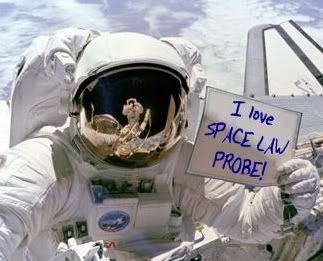12.30.2005
Year of the Satellites
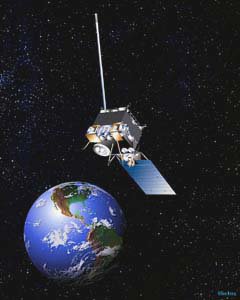 Way back in 1982, Time magazine's Person of the Year was a machine: the computer. Those were the days. And why not? Time defines "Person of the Year" as "the man, woman, couple, group, idea, place, or machine that -- for better or worse -- has most influenced events in the preceding year."
Way back in 1982, Time magazine's Person of the Year was a machine: the computer. Those were the days. And why not? Time defines "Person of the Year" as "the man, woman, couple, group, idea, place, or machine that -- for better or worse -- has most influenced events in the preceding year."In the spirit of that, this year, for the person, idea, machine, whatever-you-call-it of the year, while as everyone has heard, Time honors three globally famous good Samaritans as its 2005 Persons of the Year, I'd like to cast my vote for the non-human Samaritans of the year: the satellite.
But is it possible to 'influence events,' to use Time's criteria, by orbiting above them? You bet. Of course, there are more than 800 active satellites currently in orbit around earth, (most of which belong to the US,) and many of them qualify, one way or another, for this year's honor. I'm talking about satellites that helped in disaster recovery. In 2005, a year marked by calamities (including the aftermath of the tsunami that hit in the last week of 2004), satellites were heroes.
With regard to hurricanes Katrina and Rita, SIA chairman Tony Trujillo testified before Congress that satellite communications "played a critical role during the response to these man-made and natural disasters. When the telephone and broadcast networks went down, satellites remained on the job. Satellites connected emergency personnel and other first responders. Satellites reunited families. Satellites reconnected communities. And, satellites enabled the world to witness the devastation of these disasters and also the many acts of heroism." (Sept. 29, 2005)
Trujillo quoted FCC Chairman Martin who said, "if we learned anything from Hurricane Katrina, it is that we cannot rely solely on terrestrial communications”.
As Futron and GVF explain in this white paper, satellite communications are "essential" for disaster management and relief.
Of course, having "eyes in the skies" is about more than communications. It's about imagery too. And lots of remote sensing satellite talent came into play in this year of natural disasters. One good example, as Leonard David reports -- to appraise hurricane damage as well as plan recovery efforts the Department of Defense's National Geospatial-Intelligence Agency helped merge both classified and commercial satellite data for FEMA.
All year, satellites did not take off a day. One year after the Asian tsunami, satellites are still helping relief and rebuilding efforts. (Spy satellites zoomed in to help victims there, too.) And satellites are helping scientists understand the dynamics of the deadly tsunami.
In Kashmir, researchers use satellite data to pinpoint the fault that caused October's deadly earthquake, to understand the "earthquake cycle" and plan emergency response in the wake of future quakes. And maps made from satellite images support ongoing relief efforts in Pakistan, northwest India and Afghanistan.
Satellites make the world smaller, as well as safer. They can work remotely to pitch in globally. For the International Charter on Space and Major Disasters, the system set up to provide "space data acquisition and delivery to those affected by natural or man-made disasters," it was quite a busy 2005. For the first time, even the US found itself beneficiary of Charter activations (for post-hurricane Louisiana, Mississippi, and Alabama.)
Of course there is nothing that satellites can actually do about the weather. But they provide nonstop coverage. And although satellites are non-political by nature, they sometimes appear to take sides, such as in the ever-heated climate change debate. (Alas, data interpretation is no satellite's forte.)
Unlike some camera-mugging celebrity Samaritans, satellites generally prefer to keep a low profile. But people take notice anyway. In his 2005 roundup in Via Satellite, telecomm lawyer Owen D. Kurtin of Brown Raysman noted "[e]normous press attention was given this year to industry players such as Orbimage and Digitalglobe for providing high-resolution images for a variety of commercially useful purposes such as disaster rescue and recovery, navigation, agriculture, traffic flow, meteorology, and security."
What else? Oh, satellites love animals. This year GPS satellites helped track endangered giant pandas in the wild. (Ok, the panda's were having sex. And yes, satellites can be voyeurs. But there is no rating system for satellite data.)
From LEO to GEO, sleepless satellites never fly from danger. And their ranks keep growing. A few days before the year closed, Europe finally launched its first Galileo satellite in the system that will rival US's GPS.
So while every day of the year satellites act as our high-flying Samaritans -- even, I'll say it, orbiting superheroes -- handling communications, navigation, remote sensing, meteorology, security and more -- in 2005, I think it is safe to say satellites may have covered more high ground than Bono, Bill and Melinda put together.
* * *
Happy new year, everyone!
12.29.2005
Got Rules?
 Some people think lawyers love rules. Nonsense. But enough about what lawyers love.
Some people think lawyers love rules. Nonsense. But enough about what lawyers love.As anticipated, (and as Clark reminded us earlier this week,) today the FAA issued its proposed rules for Human Space Flight Requirements for Crew and Space Flight Participants (-- that's a link is to the text version, or if you prefer, here's the 123 page pdf.) (14 CFR Parts 401, 415, 431, 435, 440, 450, and 460) [Docket No. FAA-2005-23449; Notice No. 05-17]
I wanted to post it as I read through, with assurances to Associate Administrator for Commercial Space Transportation Patricia G. Smith that the holiday eggnog and champagne will have worn off before we comment. Much more on this to come.
Here's the FAA's summary:
(By the way, these days, it's quick and easy to comment on NPRMs. As the FAA's notice directs, use Regulations.gov; or, go directly to the Department of Transportation's docket site -- and here is the page for the proposed commercial space requirements, FAA-2005-23449.)
The FAA proposes requirements for human space flight of crew and space flight participants as required by the Commercial Space Launch Amendments Act of 2004. If adopted, this rulemaking would establish requirements for crew qualifications, training, and notification. It would also establish training and informed consent requirements for space flight participants. The rulemaking would also modify existing financial responsibility requirements to account for the FAA's new authority for space flight participants and crew, and to issue experimental permits. The experimental permit is the subject of a separate rulemaking. The FAA is conducting this rulemaking in order to fulfill its responsibilities under the new act. The requirements are designed to provide an acceptable level of safety to the general public, and to notify individuals on board of the risks associated with a launch or reentry.
And remember, ya gotta play by the space rules.
12.28.2005
Glenn Space
(And we love that about him.)
Space enthusiasts, God knows, have seen plenty of disappointment in the past few decades, as the brief false dawn of Apollo led to years of failed promises and no visible momentum. But we're now seeing signs of new technologies -- and, just as important, new systems of organization -- that make a takeoff into sustained growth much more likely for the space sector. Prizes to develop technology, space tourism to develop markets and help us move up the learning curve, and people with the money and vision to provide the seed capital for both: The essentials now look to be in place. It's about time.Indeed.
* * *
UPDATE: I just came upon the same hot GHR quote posted on Transterrestrial Musings. (Not to brag, but many bloggers consider it a good sign when it appears they are starting to think like Rand Simberg.)
12.27.2005
Who Loves ULA?
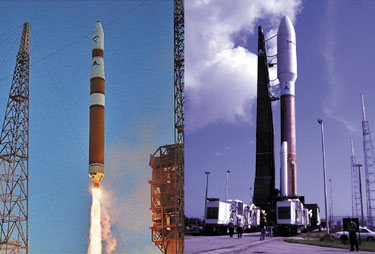 As the year closes, the fate of United Launch Alliance, the proposed Boeing Lockheed EELV joint venture announced in May remains, well, up in the air. The companies had hoped for regulatory approval by the end of 2005, but apparently the Department of Defense and FTC are not ready to sign off on the deal.
As the year closes, the fate of United Launch Alliance, the proposed Boeing Lockheed EELV joint venture announced in May remains, well, up in the air. The companies had hoped for regulatory approval by the end of 2005, but apparently the Department of Defense and FTC are not ready to sign off on the deal. (Of course the EU had no problem with it at all.)
Some interested observers, like Citizens Against Government Waste, question the economic wisdom of an alliance that would "combine the production, engineering, test and launch operations associated with US government launches" of Delta and Atlas boosters.
In that vein, in an open letter to Congress this week, (as you may have read on Jeff's blog,) the National Taxpayers Union (NTU) vented its feelings about the joint venture. Urging "a return to price-competitive acquisitions," the NTU challenged the companies' projected annual savings to the Air Force of $100-150 million (which by the way is one quarter of the amount last week's NYC transit strike reportedly cost the city per day) as "dubious on its face," and said any savings that "might result from the merger will be more than offset by increases in taxpayer-funded subsidies to Boeing and Lockheed ... ultimately costing taxpayers upwards of $500 million per year due to the Air Force's EELV acquisition strategy."
One calculus seems clearer: Boeing stands to save mucho megabucks if its former rival drops its federal suit for trade secret theft. (I haven't seen the JV agreement but as Boeing's May 4, 2005 8K (-- that's a required SEC filing for you non-corporate lawyer types) -- specifies, the "Master Agreement provides that Boeing and Lockheed Martin will promptly request an order from the U.S. District Court suspending all activity in the pending civil litigation between them related to a previous competition for launches under the Air Force Evolved ELV program. As of the closing of the transactions contemplated by the Master Agreement, the parties will enter into a final settlement agreement and will dismiss all pending claims in the civil proceeding." Well that's one way to resolve a lawsuit.
Space policy experts offer mixed views of ULA. In his commentary in BusinessWeek, Stan Crock collected some opinions:
John Logsdon, director of George Washington University's Space Policy Institute said, "The country shouldn't have to pay the price of maintaining two totally separate production lines and engineering forces."
Loren Thompson, COO of the Lexington Institute said if "demand for launches continues to be slack, 'there isn't much alternative' to the merger."
And John Pike, director of Globalsecurity.org, told Stan, "With the merger, 'we get the 'benefits' of high costs from two production lines and the 'benefits' of high costs from having a monopoly supplier,' and 'If you want to imagine the least efficient way possible of doing it, this is it.'
Meanwhile, as Boeing and Lockheed try their hand at bonding, many hearts have been stolen by the start-up that may change everything.
And we know how SpaceX feels about ULA.
(image credit: AFA.org)
12.23.2005
Revenge of the Star Wars Holiday Special
 Although according to Now Playing magazine, George Lucas' "much-maligned 1978 TV one-shot The Star Wars Holiday Special will never be seen again by mortal eyes – presumably because it’s so god-awful," the editors of the mag have taken the opportunity to dream up their own sequels for the TV series, in case George (aka "the flanneled one") is looking for ideas. (Actually, after the launch of Pajamas Media, I thought the Instapundit was the new flanneled one. Or is he the denimed one? Around bloggywood he's more famous than Lucas anyway.)
Although according to Now Playing magazine, George Lucas' "much-maligned 1978 TV one-shot The Star Wars Holiday Special will never be seen again by mortal eyes – presumably because it’s so god-awful," the editors of the mag have taken the opportunity to dream up their own sequels for the TV series, in case George (aka "the flanneled one") is looking for ideas. (Actually, after the launch of Pajamas Media, I thought the Instapundit was the new flanneled one. Or is he the denimed one? Around bloggywood he's more famous than Lucas anyway.)Here's the best sequel idea, and you immediately see why:
* * *
"The Angriest Planet in the Galaxy: Original Star Wars stars Mark Hamill, Harrison Ford, and Carrie Fisher join together for a rare appearance as their characters Luke Skywalker, Han Solo, and Leia Organa. The original Jedi, rogue, and princess, joined by a space lawyer played by Calista Flockhart, must travel to the Angriest Planet in the Galaxy, where washed-up movie stars, earring-wearing mid-life crisis sufferers, overweight script doctors, and ex-sitcom actresses reign supreme. 'I’ve got a bad feeling about this...'"
* * *
Indeed... ;)
Enjoy your holidays, everyone!!
(Yoda available at Paizo)
12.20.2005
Gettin' Jiggy in Space
 Today I don't want to talk about anything that has to do with transportation, including the scrubbed Falcon 1 launch yesterday (-- keep the faith, Elon!--) or the NYC transit strike that began this morning (my feet are still sore from walking to midtown at 7:00am, and I'm not looking forward to the rest of the week). So what else is there? Ok, sex.
Today I don't want to talk about anything that has to do with transportation, including the scrubbed Falcon 1 launch yesterday (-- keep the faith, Elon!--) or the NYC transit strike that began this morning (my feet are still sore from walking to midtown at 7:00am, and I'm not looking forward to the rest of the week). So what else is there? Ok, sex.Blame Taylor Dinerman; I just read his titillating article in The Space Review, The first orbital honeymoon: the next step in space tourism? Taylor has some, let's just say, romantic ideas for a "major breakthrough for space tourism" (which thankfully, Jeff did not wait until Valentine's Day to publish). Seems sex can always be counted on as a big draw, and not just at home or on the home planet. (By the way, didn't Virgin Galactic announce honeymooners George Whitesides of NSS and his bride, Loretta Hidalgo had signed-up to be the first couple to fly to orbit? Astronotes, July, 27, 2005)
Well what's wrong with proposing a new venue for human close encounters? In investigating the question, Is Sex Necessary?, Alan Farnham, in Forbes concludes, "The best that modern science can say for sexual abstinence is that it's harmless when practiced in moderation. Having regular and enthusiastic sex, by contrast, confers a host of measurable physiological advantages, whether you're male or female."
(And yes, he got paid for that.)
But last October, those buzzkills at the US National Academy of Sciences issued some new warnings about the one kind of sex nobody has ever had (or at least admits to) -- sex in space.
Apparently it took a panel of top research scientists to worry up the idea of a 30-month mission carrying a crew of six to eight vigorously healthy, adventuresome people in close quarters to a distant planet turning into Desperate Spacewives. Alas, the panel warns, spaceflight sex on the way to Mars could derail the mission.
In the book, Spacefaring: The Human Dimension, (chapter 11, Sex in Space)Albert A. Harrison observes,
NASA has avoided few topics as studiously as the subject of sex in space. Given the selection of "right stuff" male astronauts, the brevity of the missions, and the close monitoring of life aboard the spacecraft, sex was not much of an issue during the early days. In later years, public pressures may have contributed to NASA's avoidance of the topic. NASA's approach to congressional support and funding rests in part on not annoying any appreciable segment of the population. Since sex outside of marriage (or even within marriage but at taxpayer expense) still runs against the grain of some Americans, NASA's avoidance of the topic is understandable.Of course, commercial space tourists would not be having sex at taxpayer expense, as would astronauts on a government payroll.
Inevitably, as earthlings lose their space virginity, some will suggest that on a long space mission, civilization should worry if Earth's envoy's are not having cosmic sex. Out there among the stars, sexlessness just doesn't seem ...human.(See the discovery of "two fossils fused together in sexual union for 65 million years." OK, they were slime mold cells, but it was pure lust.)
In any case, the Academy recommends further study.
(Volunteers? Don't e-mail me. Really, don't. Please. Don't... Stop...)
(** image credit: Space Tourism Society)
12.19.2005
Yes worries
According to Rusty, "the general public isn’t yet aware enough of the threat itself to have any sense that prevention is of importance. Consequently the pressure on Congress to take action on this issue is low to non-existent. B612 Foundation is continually wrestling with the question, given its extremely limited resources, of where to apply its efforts, lobbying Congress for action, educating the general public, or focusing on our primary goal of getting a demonstration of deflection capability off the ground."
As Rusty mentions, and I've previously posted, Congressman Dana Rohrabacher (R-CA) has sponsored a bill to allocate $20 million for NASA to track near-Earth asteroids and comets of 100 meters or more in diameter. So far, NASA has no asteroid busting plan. We're on our own.
(Xanax anyone?)
12.16.2005
Got Clients?
Blogspace is buzzing about Michael Mealling's new COTS Watch, a blog covering all you want to know about NASA's Commercial Orbital Transportation Services (COTS) initiative. A great idea. If you have or want clients in commercial space, watch this space.
Operating out of the Rocket Dungeon (much cooler than the bat cave), Dick Stafford compiles a big databank of private space access ventures. His breakdown includes everything from vehicle type, mission, propulsion, payload, launch site, status and more. Blast over there.
At Hobby Space, Clark Lindsay gathers innovative business concepts, companies working on launch and propulsion technologies, and of course RLV's." (Clark even found a company he hadn't heard of!)
And this one you have to pay for, but Clark points to the AIAA publication, International Reference Guide to Space Launch Systems, Fourth Edition (2004), by Steven J. Isakowitz, NASA; Joshua Hopkins, Lockheed Martin; Joseph P. Hopkins Jr., Andrews Space and Technology. (Discounted for members.)
Go make friends.
(Need tips on marketing and meeting clients? Everybody can't be Peter Pettibone at Hogan & Hartson, but no worries, there's lots of help out here. Try Tom Kane's blog for some legal marketing tips, Terrie Wheeler's Marketing Basics for Lawyers: Tips, Tools and Techniques for Building your Practice, Ed Poll's LawBiz Blog, and now might be a good time for a bit of a Makeover for Your Communication Skills, from the editors of Law.com.)
12.15.2005
Spy Games ;-)
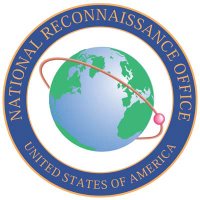
Some things that happen at the National Reconnaissance Office are classified. But SLP has reviewed publicly available intelligence that demonstrates U.S. spy tax dollars are hard at work providing for our nation's secure future, on the NRO's NRO Junior, an online training facility where future espionage professionals can hone their top-secret skills by putting together a spy satellite jigsaw puzzle (oops - didn't mean to give away the result), maneuver a spy satellite through a maze (watch out for Whirly Lizard!), build a paper plate satellite puppet, engage in a thrilling game of satellite capsule catch, or listen to patriotic tunes like, "Whosh Goes Satellite" or even "Twinkle Little Star."
Rest easy, America, the NRO is on the job and making strides pursuant to fulfilling its mission to "revolutionize global reconnaissance" and serve as "Freedom's Sentinel in Space."
(Link sent in by D.J. Den Herder, who should be working on his space law thesis at Leiden. Get back to work, D.J.!)
12.14.2005
Ready for Wikilaw?
"Wikilaw's goal is to build the largest open-content legal resource in the world. To accomplish this goal, Wikilaw needs your help! We encourage all law professors, practitioners, and students to share their knowledge.
First, Wikilaw will focus on the United States. Currently, there are roughly 1,000,000 lawyers in the United States. If every lawyer in America contributed a fraction of their legal knowledge to this site, Wikilaw would become one of the largest libraries of legal information in the world.
However, unlike other libraries, there are no geographic or financial barriers to accessing this information. Everything on this site is free!"
(1,000,000 lawyers?!)
Go for it. (Who wants to post the first Wikilaw treatise on space law?)
12.13.2005
A Hubble Moment
 By now, orbiting blogspace, you've seen this famous Hubble mosaic of the six-light-year-wide Crab Nebula. I wanted to hang it here (alas, couldn't show the movie), as the perfect holiday decoration. SLP may be just another boring black-letter blawg, but it's also part sexy space blog, happy to use any excuse to show some cosmic color. Of course, space bloggers are not Instapundit, with their own far-flung correspondents hopping around the globe, digital cameras blazing. But space bloggers know this: Hubble, with it's uniquely placed cameras, is the personal citizen photojournalist to the planet.
By now, orbiting blogspace, you've seen this famous Hubble mosaic of the six-light-year-wide Crab Nebula. I wanted to hang it here (alas, couldn't show the movie), as the perfect holiday decoration. SLP may be just another boring black-letter blawg, but it's also part sexy space blog, happy to use any excuse to show some cosmic color. Of course, space bloggers are not Instapundit, with their own far-flung correspondents hopping around the globe, digital cameras blazing. But space bloggers know this: Hubble, with it's uniquely placed cameras, is the personal citizen photojournalist to the planet.And we sure need it. I could never capture these images with my Canon Powershot SD450 5 megapixel digital Elph with 3x optical zoom, or my Konica Minolta Dimage Z5 5 megapixel with 12x anti-shake zoom. Both of which, by the way, I recommend (I bought the Dimage first, then the Elph for something smaller) and you don't even have to know how digital cameras work to fire 'em up (although neither compare to my now destroyed but ever-classic Canon A-1, the best 35mm SLR ever produced, which died in a snow storm on the beach in 1992). These gadgets are great for shooting shuttle launches or law conferences but useless for actually photo-blogging outer space.
But we have Hubble, as long at it flies. Could NASA have made Hubble images even cooler? I asked an expert, my brother Franklin, who is a digital effects artist in Hollywood (but don't click on his IMDb listing, for some reason it's incomplete -- Frank worked with the teams that won best visual effects Academy Awards for Titanic and Spider-Man 2, he also worked on digital effects for Spiderman, which received a visual effects Oscar nomination, and Batman Begins; and his newest project, Superman Returns, opens, I think, in May).
Frank says "Hubble shots are remarkably cool, especially false colored and
composited. And being actual deep space images are much cooler than anything a digital artist can come up with (for a still!) As for animated images digital artists can create more fantastical imagery since we are not bound by any rules of reality."
By the way, one of Frank's hobbies is digital stereo photography, which involves "shooting two stereo cameras at the same time. The resultant left and right images can be combined in many ways to create a 3D depth effect when viewed." To take digital stereo shots (and secure his place as the toast of all family gatherings), Frank shoots with a custom rig consisting of two Sony Cybershot 5.1 megapixel cameras sync'd internally. It's a strange looking gadget and a bit of an attention magnet. If you've never seen a digital stereo camera (most people haven't), take a look at these models. (Don't worry, you won't need 3D glasses to view the cameras.)
Hubble can't take stereoscopic pictures. As Frank says, "the interoccular distance (between the left and right eye views) would have to be in light years."
But NASA's Mars exploration rovers do 3D. Way cool. In fact, both rovers can take stereo shots with all three cameras (pancams, navcams, hazcams). The recent trouble NASA has been having with Opportunity's stalled robotic arm impaired the space buggy's ability to take stereoscopic pictures.
But I digress. Although the Crab did not make Time's list of the best photos of 2005 (an honor reserved for pictures of tsunamis, floods, hurricanes, riots, earthquakes, famines and of course, war), deck your holiday halls with Hubble shots and other pretty pictures. Because on Earth as it is from space, image is everything.
(And wait for even more amazing things from the James Webb Space Telescope, coming -- maybe? -- in 2013...)
Virgin Territory
Cookies & Space Law in NYC
**********
FREE PUBLIC ASTRONOMY LECTURE
INTERNATIONAL OUTER SPACE LAW
Where is outer space? Who can develop and exploit it? Are there conflicts and liabilities in space? How is property defined? What treaties apply? Who resolves disputes? Are settlements enforceable?
Thursday 15 December 2005, 7PM
NY Skies Astronomy Seminar
St Paul's Lutheran Church
315 West 22nd St
near 8th Av in Chelsea, NYC
With cookies and coffee
Information at
nyskiesastronomy@earthlink.net
212-273-5958
**********
Well I'm on the subway for the cookies alone. Plus, I love a good "astronomy lecture," including one that's about space law. And as I've noted before, awareness of space law is growing, and attracting increasing interest among nonlawyers too, not just folks in the space science community. For this I blame all you head-in-the-clouds space tourists and space tourist wannabes. Keep it up.
(And let me know if you'll be around. The huge Christmas/Holiday tree -- 74-foot-tall Norway spruce -- is now lit in Rockefeller Center and the 2005 Radio City Music Hall Christmas Spectacular is playing and Fifth Avenue is all decked out. For starters. Come!)
12.12.2005
Moon Planet
And then there was T.L. James' challenge (in MarsBlog) to Ryan's model, followed by Ryan's rebuttal. Good reading and I wanted to note it here. Better to blog late than never.
Speaking of international cooperation, Senate Commerce Subcommittee on Science and Space Kay Bailey Hutchison (R-TX) called last week for the U.S to finish building ISS and reach out to China and others to share costs. (Link via Keith Cowing). Of course, many have argued, as Rand Simberg puts it, "international cooperation in fact tends to increase costs, and there's little good evidence that it even saves money. It's something that we tend to do simply for the sake of international cooperation, and we actually pay a price for it." There is also the sentiment that, while nothing beats the free market for commercial ventures, when governments do space, there is a significant value to cooperation for which we have yet to develop a reasonable calculus (at least to get past what T.L. James refers to the "Kumbayaa" good will of internationalism generally, which incidentally, I have no particular problem with if it gets us there). In any case, global cooperation remains one of the many interesting challenges in space development.
(But for now...if you'll excuse me, I've got this week's edition of The Space Review waiting....)
12.08.2005
Property Panel: Recap
Space Property Rights Legal Panel, Dec. 6, 2005
"This Space Show program featured the first ever Space Property Rights Legal Panel with Wayne White, Rosanna Sattler, Jim Dunstan, and Berin Michael Szoka. The panel began this intensive and comprehensive space property rights discussion with a basic introduction to the issue of space property rights, focusing on the Outer Space Treaty along with the other U.N. treaties impacting and helping to create the existing property rights regime. This is an in-depth discussion you will not want to miss. The panel also fielded numerous listener questions concerning possible space law issues, from what we do if aliens claim asteroids, Titan, or Mars and don';t recognize our law (a most surprising answer followed from our panel members), to issues of suborbital international point to point space flight and domestic suborbital point to point space flight. Listeners also inquired about L1 regional space control as a property rights issue and much more. Issues about lunar resource discoveries were addressed, especially from the point of view what the U.S. might be obliged to share with the global community. This issues was addressed from both the perspective a government mission and a privately funded mission, including doing remote sensing and surveying from orbit by a private company. We also talked about space access and property rights as an entitlement with the government and the UN blocking people from this entitlement. The issue of the entire space property rights discussion being premature came up given the economic reality of our not being able to get to the Moon at this time, let alone leave Earth in an economic fashion. The premise of this question being put the property rights discussion on hold until its relevant. To conclude the panel discussion, each panel member made a summary statement and offered us a his or her view as to what needs to be done next to move the cause of space property rights forward. To facilitate questions and comments for the panel members, you are welcome to send any and all comments to me at drspace@thespaceshow.com. If you target a question or comment to a specific panel member, I will forward your email to that panel member. If you comment or question is not targeted to any one person, I will send it to all four panel members."
* * *
About our guests...
Jim Dunstan
James E. Dunstan is a partner in the Washington, D.C. office of Garvey Schubert Barer, where he concentrates on issues of high technology, communications, and space law. Jim represents a significant number of burgeoning outer space companies: he drafted and negotiated the first commercial lease for the Russian Mir space station on behalf of MirCorp. He has drafted and helped negotiate contracts with several potential space tourists. Jim was a founding board member of LunaCorp and assisted in negotiating with the Russian Space Agency and NASA to shoot the first television commercial onboard the International Space Station (ISS). He helped arrange for the first pitch of the 2002 baseball World Series to be conducted onboard ISS. Mr. Dunstan has also been involved in export issues (ITAR) related to experimental hardware launched on Russian rockets. Not satisfied strictly practicing law (or maybe just suffering from a lingering bout of ADD), Jim has created a number of multimedia computer programs, including most of the coding for Return to the Moon and Mission: Planet Earth, as well as writing the motion code for the motion-platform based video arcade game, Lunar Defense. Jim worked with the Robotics Institute at Carnegie Mellon University in 1997 as the lead programmer in a project to demonstrate real-time remote "telepresence," by bringing back video and motion data from a robot in the Chilean desert and feeding it realtime into a motion platform system at the Carnegie Science Center in Pittsburgh. Jim has designed dozens of robots and user interfaces to allow non-scientists to interact with and control remote exploration vehicles.
Rosanna Sattler
Rosanna Sattler is a partner with the Boston law firm of Posternak Blankstein & Lund, LLP, and chair of the firm’s Space Law and Telecommunication Group, as well as its Environmental Group, with extensive knowledge about a range of emerging legal issues in the commercialization of outer space. In her 27-year career, Rosanna has earned a national reputation representing companies in high-profile commercial disputes, as well as in highly publicized environmental matters. She regularly provides consulting services to companies regarding compliance with federal and state regulations. She frequently represents clients before federal and state agencies. Rosanna has rendered legal services to the Space Frontier Foundation with respect to a NASA grant addressing the environmental impact of solar power satellites. She was a presenter at the International Space Business Council Law Forum at the National Press Club concerning orbital debris and the environment. Rosanna was a panelist on Space Property Rights at the Return to the Moon VI Conference, sponsored by the Space Frontier Foundation, in July 2005. She will also be a presenter at the International Lunar Conference, Toronto, Canada, in September 2005 on the topic of transporting a legal system from the Earth to the Moon. She is a member of the U.S. Chamber of Commerce, Space Enterprise Council, Charter member of the Board of Directors. American Bar Association, Forum on Air and Space Law, Space, Inc., Pro Space, Inc - Chair of the Board of Directors, Space Frontier Foundation Advocate, National Space Society, and Federation of American Scientists.
Berin M Szoka
Berin Michael Szoka is the Executive Director of the Institute for Space Law & Policy, a non-profit, public interest think tank dedicated to developing the legal and regulatory framework necessary to enable the development of space. He is a graduate of Duke University and Virginia Law and is admitted to practice in California. Before founding the Institute with Rick Tumlinson, Ed Hudgins, Jim Dunstan and others, he clerked for the Hon. H. Dale Cook, Senior U.S. District Judge for the Northern District of Oklahoma. He currently works at the telecommunications law boutique Lawler Metzger in Washington, DC, and has previously worked at Morrison & Foerster, the Institute for Justice and the Cato Institute.
Wayne White
Wayne White is an attorney and space law consultant. He practices law in Boulder Colorado. Mr. White graduated from Chapman University, received a Masters Degree in Business Administration from U.C. Riverside, and received his law degree from U.C. Davis. In 2003, Mr. White had the honor of representing the United States as a member of the U.S. delegation to the UN Committee on the Peaceful Uses of Outer Space, Legal Subcommittee. Mr. White previously served as Associate Director of the National Remote Sensing and Space Law Center at the University of Mississippi School of Law, practiced law near Denver Colorado for seven years, worked as a member of the General Counsel's office of the University of California, and was a real estate attorney for Winchell's Donut Houses Operating Company, L.P. He was a Director of the National Space Society from 2000 through 2004 and was Chair of the Society's International Space Development Conference in 2002. Mr. White is also a member of the International Institute of Space Law, the International Law Association, and the Space Frontier Society. Mr. White has written 11 published articles in the field of international outer space law.
12.07.2005
Ultimate Fighting at NASA

Here are a few lovely holiday stocking stuffer ideas for the second in command at NASA. I suggest tickets to UFC Ultimate Fight Night. Or, perhaps, the Ultimate Fighter Season 1 DVD Set. Or even this fashionable "I Love UFC" women's white tee shirt.
A lady, especially one who is a famous lawyer and high-powered government official, needs to relax. And as Jeff Foust reports from the Women in Aerospace breakfast honoring NASA women leaders this week, Shana Dale made mention of at least one of her interests outside of the space arena: "The Oxygen Channel? I don't watch TV that much, and it's usually just the news or C-SPAN. But, you know, when I do, I watch Ultimate Fighting on Spike TV."
I'm with Ms. Dale. Of course, ultimate fighting is not for everyone. My kickboxing instructor Kurt, for example, said he'd much rather meditate or do yoga than watch the fights on Spike TV. (I asked him after class last night.) But some of us girls just can't resist the action.
This leads Jeff to wonder "whether there is any similarity between Ultimate Fighting and, say, the NASA appropriations process." As a fight fan, all I can say is, let's hope so!
Space Gifts for Europe
This week, in their first conference in four years, held Dec. 5-6 in Berlin, the Euro ministers responsible for space, while not wearing Santa suits, gave ESA nearly everything it wished for, including a Mars rover. (That's ExoMars, not Beagle 3.)
The ESA member nations approved an $9.6 billion budget for 2006-08 that includes 700 million euro (($824 million) for ISS along with a generous 253 million euro ($298 million) for the Global Monitoring for Environment and Security (GMES) satellite system.
But they denied a requested 51 million euros to fund ESA work on Russia's Kliper (or is it Clipper?) space plane programme, a craft intended to replace Soyuz (or, as Space.com and others say, serve as Russia's alternative to NASA's CEV).
The members also passed a resolution for member states to use European launch vehicles. (Alas, no mention was made of any U.S. launch crisis. Link via Rand Simberg)
(Here's audio of ESA's press conference. And New Scientist (Maggie McKee) has this overview of the ministers' meeting.
Of course, another meeting is planned for 2008.
Happy holidays.
* * *
And speaking of space budgets, over at NASA Watch, Keith Cowing looks at NASA's FY 2007 budget submission to OMB.
12.06.2005
An Earful of Space Law
Listen live at 7:00-8:30PM Pacific Time (that's 10:00 to me in NYC). But don't worry about the schedule. (And this is at least one reason I went out this weekend and replaced my lost iPod with a shiny new one: cool podcasts of The Space Show -- since I always miss it live.)
And for more of your podcast consuming pleasure, here is just a sampling of some of the recent programming from the Show of particular interest to space law buffs:
Rosanna Sattler (Sept. 20, 2005)
Kerry Scarlott (Nov. 15, 2005) - talking about ITAR
Declan O'Donnell (July 31, 2005)
Also, coming up Saturday, Jan. 7, 2006: 12:00-1:30PM PT, Prof. Joanne Gabrynowicz will talk about space law issues and, her favorite, remote sensing.
By the way, for a past appearance of Prof. Gabrynowicz (who must be back by now from that UN space law conference in Nigeria) tune into this broadcast from September, 2004 (-- that was before podcasting of the show, which began in January, but listen via the .wma file.) And browse the archive for more cool broadcasts of the authoritative and interesting show.
A basket of space flowers from SLP to Dr. David Livingston.
12.05.2005
Got Global Issues?
Think cosmically, act globally.
12.02.2005
Google's Earth, Not Yours
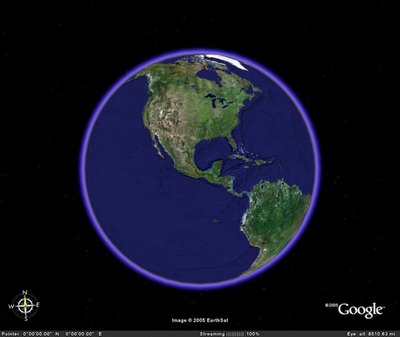 I was going to do a Friday Flybys post today, but I got distracted flying around myself, on Google Earth. Wicked fun. By now everyone has heard the objections raised by various governments around our great googled planet to all this addictive, mischief-inspiring, free-for-all openness. What illustrates the ol' transparency vs. security quandary better than Google Earth's swooping software? Governments are convinced Google Earth threatens democracy, and that the high-res sat images Google uses, which, of course, are all legally and commercially available, not in real time and up to three years old, compromise their national security.
I was going to do a Friday Flybys post today, but I got distracted flying around myself, on Google Earth. Wicked fun. By now everyone has heard the objections raised by various governments around our great googled planet to all this addictive, mischief-inspiring, free-for-all openness. What illustrates the ol' transparency vs. security quandary better than Google Earth's swooping software? Governments are convinced Google Earth threatens democracy, and that the high-res sat images Google uses, which, of course, are all legally and commercially available, not in real time and up to three years old, compromise their national security.As to those complaining governments, Prof. Ray Williamson of George Washington University's Space Policy Institute told the Christian Science Monitor, "From a legal standpoint, they haven't got a leg to stand on. There's no law on the books about this, so the government's not likely to limit the availability of these images."
Of course, we do have the 1986 UN Principles Relating to Remote Sensing of the Earth from Outer Space, in particular, Art. IV, which states remote sensing activities "shall not be conducted in a manner detrimental to the legitimate rights and interests of the sensed State." (The principles may be a good statement of customary international law even if not binding like treaty law.)
Prof. Ram Jakhu of McGill University's Institute of Air and Space Law, opines (also in the above-linked csmonitor.com article) that as a UN member state, "The US is under obligation to make sure these images are not being distributed in a manner other countries consider harmful," and notes, it's "in the interest of all countries for these complaints to be addressed."
For its part, Google says, "We take security issues very seriously and are willing to talk with representatives from individual countries." (And...?)
Meanwhile, Google on, everyone.
12.01.2005
The Islamic Republic of Space
As we know, Iran became a space power in October when it launched Sina-1, a small Russian-built satellite, aboard a Russian rocket. (Next up, another satellite, Mezbah. And reportedly coming, Iran's Shahab-4 launcher.)
Globalsecurity.org also has this backgrounder.
And some of you may recall, or have actually attended, last year's workshop in Tehran presented by the United Nations Office for Outer Space Affairs and the Islamic Republic of Iran, titled Regional Workshop on the Use of Space Technology for Environmental Security, Disaster Rehabilitation and Sustainable Development (May 8–12, 2004). Some materials from that workshop are now posted, including a statement by Hassan Shafti, then president of the Iran Space Agency, which included this observation about Iran's space plans,
"Moreover, in the field of the aerospace, we have taken effective steps forward in capacity building in aerospace sector through training the specialized manpower in undergraduate, postgraduate and PhD levels in the recent two decades.
Furthermore, with the establishment of Iran Space Agency in the recent months, our country took a very fundamental step forward. Iran Space Agency will have an important role at the outer space, enhancement of knowledge and experience, and extensive cooperation at the regional and international level. This cooperation will also include the design, manufacturing and launching national and regional satellites.
Our expertise now with an appropriate background of knowledge and expertise are prepared to take more active role in the international collaboration and cooperation.
(No mention of spying on Israel there.)
And here's the Iran Space Agency (or, if you prefer, and I do, the English version.)


